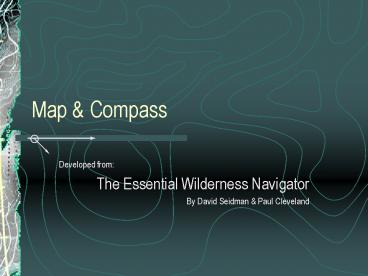Map - PowerPoint PPT Presentation
1 / 23
Title: Map
1
Map Compass
- Developed from
- The Essential Wilderness Navigator
- By David Seidman Paul Cleveland
2
Types of Maps
Planimetric Road Map
National Ocean Survey Chart
USGS Topographic Map
Cape Rosier, Maine
3
USGS Topographical Maps
- Symbols
- Legend
- Contour Lines
- Slope Profiles
- Slope Gradient
- Latitude Longitude
- Scale
- Declination
4
Perspectives
A rugged landscape as depicted
X
(1) on a topo map
(2) from a birds-eye view
(3) Your view south from the spot marked X
5
Shaded Relief
USGS Topographical
Same Quad with Shading
6
Reading the Terrain
7
Contour Lines
Gentle Slope
Ridge or Summit
Mountainside w Cliff
Moderate Slope
Bowl
Gully
Steep Hill
Saddle, Pass, or Col
Ridge
8
Rules for Interpreting Contours
- There is no beginning or end to a contour line.
It is an irregularly shaped closed loop. - The steeper the slope, the closer the spacing
between lines. - Your trail is going uphill if it regularly
crosses contour lines of increasing elevation.
- Valleys usually show up as a series of V-shaped
lines pointing toward higher ground. - Ridges can be shaped like a series of Vs or Us
pointing toward lower ground. - A pass or saddle in a ridge has higher contour
lines on each side, giving it a characteristic
hourglass shape.
9
Rules for Interpreting Contours
- To determine if a group of U or V shaped contours
shows a ridge or a valley, check the elevation of
the contour indexes to see which way the ground
is sloping, or check to see if a stream runs down
the middle or side of the Vs.
- Contour lines running up one side of a river or
stream, crossing it, and running back down the
other side form a U or a V that points upstream. - A peak is depicted by the innermost ring of a
near-concentric pattern of contour lines. It is
marked with elevation and sometimes an X.
10
Scale
- A map is reality reduced to manageable size, with
every detail uniformly proportioned to what it
represents. The maps scale, or degree of
reduction, is noted along its bottom border. - Scale is most often expressed as a ratio called
representation fraction.
- A scale of 124,000 means that 1 inch on the map
represents 24,000 inches in the real world. - The bigger the second number, the smaller the
scale the smaller the second number, the larger
the scale.
1250,000 small scale small detail 124,000
large scale large detail
11
Slope Gradient
- We utilize slope gradient as an important
variable in determining a trails level of
difficulty. - The change in elevation, which is the vertical
distance (contour lines) - The length of the trail, which is the horizontal
distance (maps scale)
12
Route Profile
13
Slope Perspective
- Four views of a mountain.
- A familiar landmark can look very different when
viewed from an unfamiliar perspective.
14
Latitude Longitude
- Lines of latitude run horizontally, East West,
and lie parallel to one another. - Measure distance North South of the equator.
- Lines of longitude run vertically North South,
but are not parallel. - Measure distance East West of Greenwich,
England.
15
Which Way is North?
- Geographic or True North
- At one end of the axis around which the earth
spins. - Map makers place geographic North at the top of
the world. - Magnetic North
- At the Northern end of the planets magnetic core,
West of Baffin Island. - The compass is attracted to magnetic North.
16
Declination The Difference between Geographic
and Magnetic North
17
Direction
Cardinal Intercardinal points
Degrees
Typical combination
18
Compass Types
Fixed Dial
Magnetic Card Marine Car
Magnetic Card Military Lensatic
19
Baseplate Compass
20
When All Else Fails
- Iron or Steel
- A pin or Needle
- Piece of Barbed Wire
- No Drafts
- Small Container
- Magnetize if Possible
- Magnet
- Stone
- Silk
21
Map Software
- TopoUSA
22
Skills Challenge
- topoliteracy
23
Challenge
- Test your topoliteracy by matching the topo views
on the left (1 5) to the appropriate profiles
on the right (A E).































